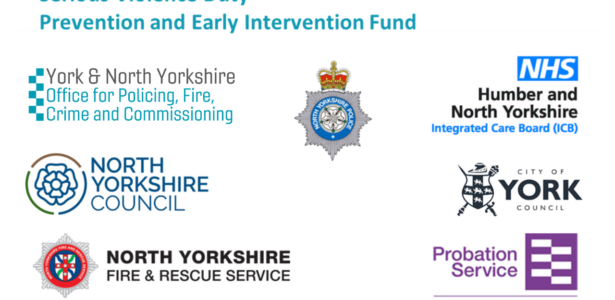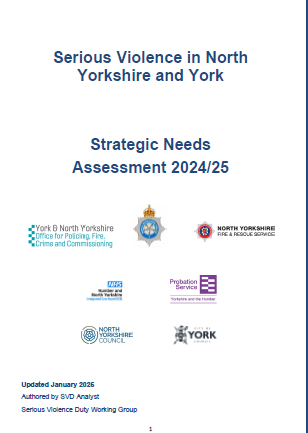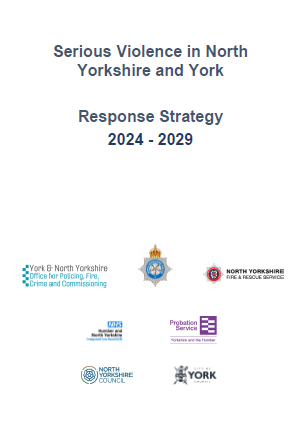Serious Violence Duty

On this page
Background
The Duty, introduced in January 2023, requires the OPFCC to convene partners including North Yorkshire Police, North Yorkshire Fire and Rescue Service, Probation services, North Yorkshire Council, City of York Council and the Humber and North Yorkshire Integrated Care Board to work together to prevent and reduce Serious Violence that occurs in the area, develop a Strategic Needs Assessment (SNA) and implement a Response Strategy to address it.
The full national guidance can be found here: Serious Violence Duty – Statutory Guidance (publishing.service.gov.uk)
North Yorkshire and York Approach
The aims of the North Yorkshire and York response to Serious Violence are:
- To understand the extent of violence throughout North Yorkshire and York, through the analysis of characteristics, patterns of behaviour and the impact on the wider community.
- To establish the risk factors that increase the likelihood of violence, and how these factors can be reduced through prevention, diversion, and early intervention.
- To establish effective interventions in a variety of settings and monitor the impact on reducing serious violence these interventions produce.
Definition
The Serious Violence Duty is not given a set definition of serious violence, and each local area is encouraged to set their own definition.
The definition of serious violence for North Yorkshire and York reflects issues found within the local area, and the impact and prevalence of different types of serious violence.
Therefore, for North Yorkshire and York, the following crimes are included in our definition of serious violence and were used during the Strategic Needs Assessment (SNA):
- Homicide
- Violence with Injury (Attempted Murder, Endangering Life, Grievous Bodily Harm, Actual Bodily Harm, Administering Poison with Intent to Injure, Non-Fatal Strangulation and Suffocation)
- Domestic Abuse
- Rape and Sexual Offences
- Weapon Related Violence; including Weapon Possession
- Arson Endangering Life
- Stalking and Harassment; non-domestic
In addition, the following areas of thematic interest are considered within the wider profile:
- Violence Against Women and Girls (VAWG)
- Young People
- Alcohol and Substance Misuse
- Mental Health
- Deprivation and Employment
- Education
Rationale:
Some categories were considered for inclusion but excluded due to being covered by governance structures elsewhere.
- All HO Classifications under the ‘Violence without Injury’ subgroup have been excluded as they do not involve serious violence.
- County lines activity has the propensity for violence; however, this has not been included as a separate theme as it will be covered in the Drugs Market Profile, Drugs Strategy and Drug & Alcohol SNA.
- Modern Slavery has not been included, however any incidents with serious violence linked to victims of modern slavery will be picked up within the data set and noted within the SNA.
Our aims are:
- To understand the extent of violence throughout North Yorkshire through the analysis of characteristics, patterns of behaviour and the impact on the wider community.
- To establish the risk factors that increase the likelihood of violence, and how these factors can be reduced through prevention, diversion, and early intervention.
- To establish effective interventions in a variety of settings and monitor the impact on reducing serious violence these interventions produce.
North Yorkshire and York Strategic Needs Assessment (SNA)
The North Yorkshire and York SNA and Response Strategy adopts a Prevention and Early Intervention, Public Health Approach. A public health approach is defined by using data, intelligence, and case studies to identify the extend of serious violence and what impact this has on perpetrators, victims of crime, and the wider community. In using this approach, interventions are not constrained by organisational or professional boundaries and focus on improving population health and wellbeing through long term solutions.
Serious Violence can be prevented, and through the reduction of risk factors in common public health issues, this can be sustainable. Due to the wide range of issues which contribute to serious violence, a public health approach naturally lends itself to the problem.
Public Health England’s public health approach to serious violence identifies the ‘5 C’s approach’ – collaboration, co-production, cooperation in data and intelligence sharing, counter-narrative, and community consensus. This approach will be applied within the North Yorkshire Serious Violence Duty.
Three levels of prevention are identified and can be applied to different cohorts of offenders or potential offenders. A high-risk cohort requires a reduction in offending and tertiary prevention, the at-risk cohort requires early intervention and therefore secondary intervention, and the low-risk cohort needs primary prevention.
| Primary prevention | Preventing the problem occurring in the first place. |
| Secondary prevention | Intervening early when the problem emerges. |
| Tertiary prevention | Managing the problem and reducing harmful consequences. |

North Yorkshire and York Serious Violence Duty Strategy 2024-2029

